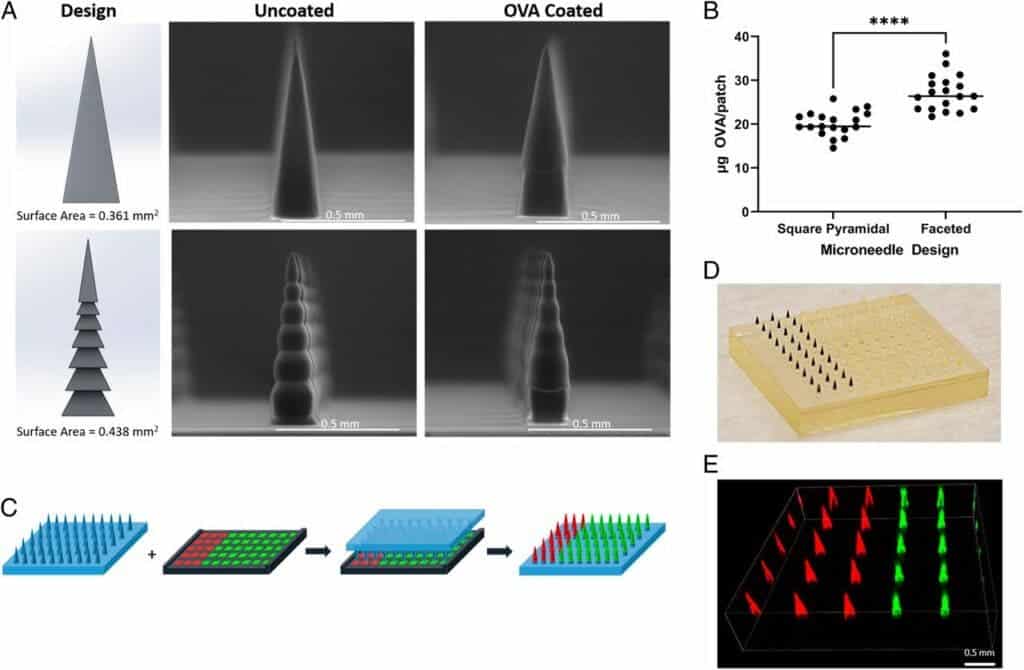Do you hate needles, but still want to get vaccinated? Researchers at Stanford University and the University of North Carolina at Chapel Hill have got your back. They developed a new, 3D-printed patch that can get you immunized without any jab.

The patch works even better than a traditional vaccine, its designers explain, as it delivers the compound directly into the skin — which is full of immune cells that respond to it. The resulting immune response is around 10 times greater than that produced by injection through a needle into muscle tissue. However, these findings, for now, should be taken with a pinch of salt; they were obtained from a study conducted with animals, not humans.
Performance patch
“In developing this technology, we hope to set the foundation for even more rapid global development of vaccines, at lower doses, in a pain- and anxiety-free manner,” said lead study author and 3D printing entrepreneur Joseph M. DeSimone, professor of translational medicine and chemical engineering at Stanford University and professor emeritus at UNC-Chapel Hill.
To be fair, it isn’t the patch itself that does the job, but rows upon rows of microneedles coated in vaccine on its underside. These are lined up and, individually, they’re barely long enough to reach the skin, where they dissolve, releasing the vaccine.
One of the main selling points of this technology, in the eyes of the authors, is the ease of use and transportability. For patients, it’s likely that the painlessness of this over other delivery methods will be its most attractive trait, as will the fact that they can administer the patches to themselves without any type of risk.
Application of this patch led to a significant antibody response in lab animals. According to the team, this response was 50 times greater than what would be produced by a direct injection under the skin. This increased response could lead to dose sparing — essentially, immunizing a larger crowd of people on the same quantity of vaccine — as each patch uses a smaller dose to produce the same response as delivery via syringe.
The concept of microneedles has been of interest to the scientific community for quite some time now, but they never really caught on due to difficulties in customizing them for different vaccines. Although 3D printing has given the authors a way to break through past limitations, it’s generally a challenge to adapt microneedles to different vaccine types:
“These issues, coupled with manufacturing challenges, have arguably held back the field of microneedles for vaccine delivery,” said lead study author Shaomin Tian, a researcher in the Department of Microbiology and Immunology in the UNC School of Medicine. “Our approach allows us to directly 3D print the microneedles which gives us lots of design latitude for making the best microneedles from a performance and cost point-of-view.”
Instead of relying on the traditional approach of creating a mold and then casting the microneedles, the team prints each one out individually. This was carried out at the University of North Carolina at Chapel Hill using a CLIP prototype 3D printer that DeSimone invented and is produced by CARBON, a Silicon Valley company he co-founded.
Although the quick development of a vaccine remains a key aspect of fighting against a pandemic, our experiences this last year have shown that logistical factors remain an important component limiting our ability to react. This process seems simple — go to a hospital, have someone retrieve a vaccine from a freezer, draw it into a syringe, and administer the shot — but it still poses quite some hurdles from a mass-vaccination standpoint.
For starters, such an approach simply cannot work in areas that lack cold storage, or where there aren’t enough trained professionals to perform the vaccinations. Getting a shot this way also involves going to a hospital or clinic, something not everybody is able or willing to do.
These patches, the team explains, can be delivered anywhere in the world without any special requirements for storage or transportation. They can be applied easily and safely at home without the presence of any trained individuals. This, by itself, could also help boost vaccination rates, the team adds.
“One of the biggest lessons we’ve learned during the pandemic is that innovation in science and technology can make or break a global response,” DeSimone said. “Thankfully we have biotech and health care workers pushing the envelope for us all.”
The paper “Transdermal vaccination via 3D-printed microneedles induces potent humoral and cellular immunity” has been published in the journal PNAS.






